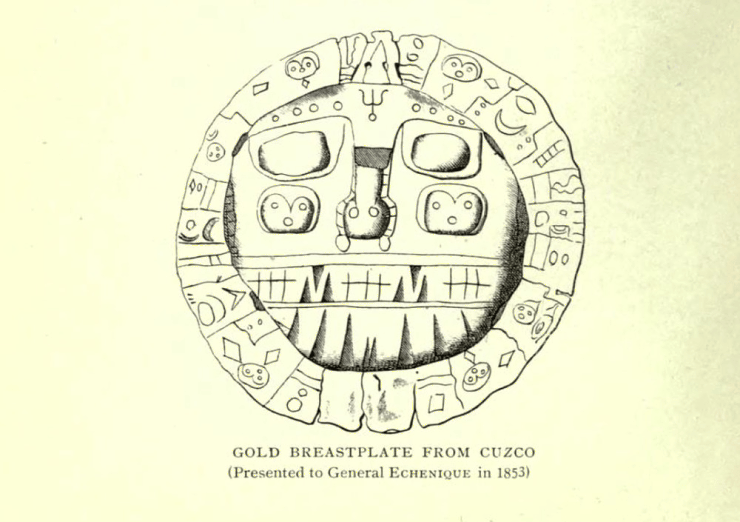
A 2,000-year-old golden disk - a symbol of national identity - has returned to Peru after 170 years
Categories: Nálezy nejenom s detektorem kovů v USA, severní a jižní Americe
The National Museum of the American Indian has signed a memorandum with the Peruvian government to return the pre-Inca gold disk, the symbol and coat of arms of the city of Cusco, back to the country. An exceptional artifact of previously unknown significance and an interesting history of its owners, one of whom was even President of Peru, will finally return to its place of origin.
The 13.5 cm diameter disc is made of a very thin layer of hammered gold. The alloy is of relatively high quality - 90% gold, 5% silver and 5% copper, equivalent to today's 22 carats. The head of a cat-like beast with large rounded eyes and snout, a fairly common Peruvian theme, is clearly visible in the centre. The golden disc symbolized a supernatural being - perhaps a deity - and indicated the high status of its owner. The holes in it suggest that it was worn as an ornamental pendant.
The outer circumference is evenly divided into 20 parts, which depict various symbols - such as anthropomorphic figures, geometric shapes, crescents, etc... Their cumulative meaning has not yet been deciphered, but may suggest that the disc may have been a solar or lunar calendar. Although more than 2,000 years old, it is a masterful example of ancient Andean goldsmithing.
As with many other important cultural heritage artefacts that have ended up far from their place of origin, the history of the disc is shrouded in mystery. It first appeared in an account from 1853, when it was dedicated during a ceremonial visit to Cusco as a ceremonial gift (along with several other antiquities) to the then Peruvian President José Rufin Echenique. However, where the disc came from, who gave it to the President, as well as the history prior to this recording, is unknown.
Later, the disc and other items literally "disappeared" from the world. Julio Tello Rojas, the father of Peruvian archaeology, attempted to track them down in the 1920s but was unsuccessful. He believed they were shipped to Chile, where they perished in the Santiago fire. He was only partially wrong: In 1912, they were actually sold by a German physician, Dr. Edward Gaffron, who stayed in Peru for several decades (during which time he built up a huge collection of ancient Peruvianartifacts) to collector George Heye, founder of the Museum of the American Indian in New York, later incorporated into the Smithsonian Institution as the National Museum of the American Indian.
Institute records indicate that the disc was inherited by one of Echenique's daughters, who later sold it to Gaffron, and that there are at least two other artifacts in the museum that were probably part of Echenique's collection. One is an unspecified gold object with engravings of figures and ornaments dominated by the head of a cat-like beast, similar to the one on the gold disc. It is now housed in the Metropolitan Museum of Art. Its provenance is also unknown. There is virtually no information before 1850, and virtually none after that year until the purchase from a German private collection in 1942. The German connection is interesting; perhaps Dr. Gaffron had more similar items from the Echenique hoard...
The choice of the gold disc as the official emblem of Cusco was important for the city. In fact, in 1986, the city council passed a law prohibiting the use of any Spanish colonialist imagery in Cusco's coat of arms. Today, replicas of the emblem adorn the streets, fountains and buildings of the historic centre of the city. The original has now been returned to Cusco for permanent display on 15 June, and was presented to the public on 24 June - the most important day of the celebration of the Festival of the Sun, an ancient Inca ritual.
"Peru marks 200 years of independence in 2021," said Machel Monenerkit, director of the National Museum of the American Indian. "In recognition of this important event and the immense significance the drive represents for the people of Peru, I am proud to be a part of this moment. The return of the disc is in keeping with the museum's mission to facilitate the continuity and renewal of indigenous cultural traditions. Thank you to the Peruvian government for their cooperation in this achievement."
The collaboration between the Smithsonian Institution and the Government of Peru, through the Ministries of Culture and Foreign Affairs and the City of Cusco, on behalf of the citizens and indigenouscommunities in Peru ensures that the use, care and exhibitions of the "Echenique Disc" respond to the wishes and recommendations of the indigenous communities in Cusco. The Golden Disk will be included by the Ministry of Culture in the National Inventory of Cultural Heritage of Peru.
Roman Nemec



Sources: si.edu, thehistoryblog.com, smithsonianmag.com
The article is included in categories:



